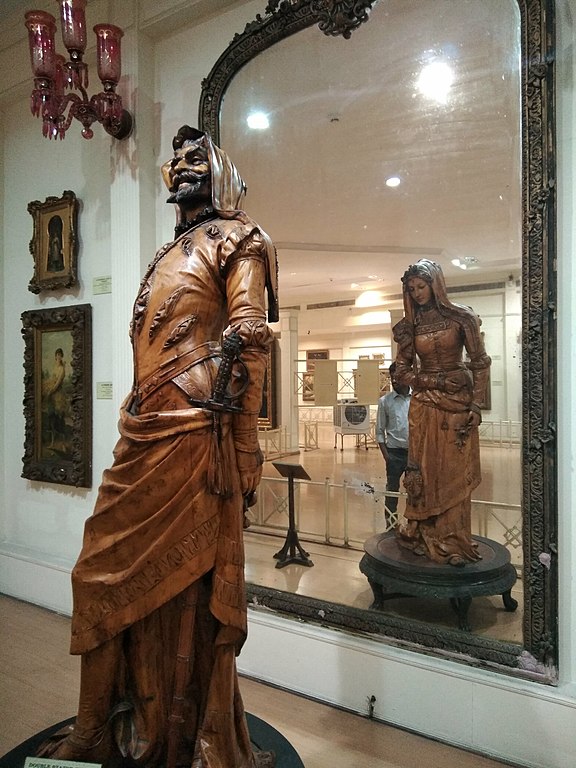
This 19th-century sculpture manages to find two characters from Goethe’s Faust in a single piece of sycamore.
It resides in the Salar Jung Museum in Hyderabad. The artist is unknown.

This 19th-century sculpture manages to find two characters from Goethe’s Faust in a single piece of sycamore.
It resides in the Salar Jung Museum in Hyderabad. The artist is unknown.
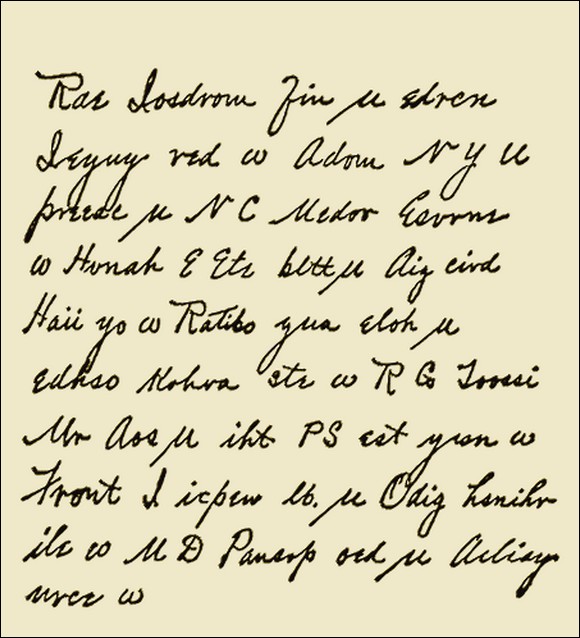
In Lloyd C. Douglas’ 1929 novel Magnificent Obsession, a doctor dies of a heart attack, leaving behind a journal written in cipher. The first page is shown here. Can you read it?
William Wallace Cook (1867-1933) claimed to have worn out 25 typewriters in as many years turning out hundreds of nickel and dime novels, all of them written in the same format, 40,000 words divided into 16 chapters of five single-spaced pages each. At the end of his career he published his system for generating plots, billed as “Plotto, an invention which reduces literature to an exact science.”
The “invention” is really a list of story ideas, all molded to Cook’s basic notion of a plot: “Purpose, opposed by Obstacle, yields Conflict.” The protagonist wants to find happiness in love and courtship, married life, or enterprise; he encounters a conflict and must reach a resolution. What makes the book fun is the absurd specificity of some of the ideas. Here’s an example:
1367
(b) (1083)(1287)
A has invented a life preserver for the use of shipwrecked persons*
A, in order to prove the value of the life preserver he has invented, dons the rubber suit, inflates it and secretly, by night, drops overboard from a steamer on the high seas.** (1414b) (1419b)
The numbers refer to elements that might be varied, to related plots, and to character types that might figure in the story. Varying the combinations might produce several million different stories. This is certainly formulaic, but, Cook said, “There are any number of highbrow authors who will ridicule this invention in public and use it in private.” (In fact both Alfred Hitchcock and Erle Stanley Gardner admitted in interviews that they’d read the book, which went through multiple editions.)
The numbered master list gives 1,462 plots, all linked with character symbols and apparently all thought up by the author. The full text is on the Internet Archive.
Vivid comparisons, from Elyse Sommer and Mike Sommer’s Similes Dictionary, 1988:
“Strong men are made by opposition,” wrote Frank Harris. “Like kites they go up against the wind.”
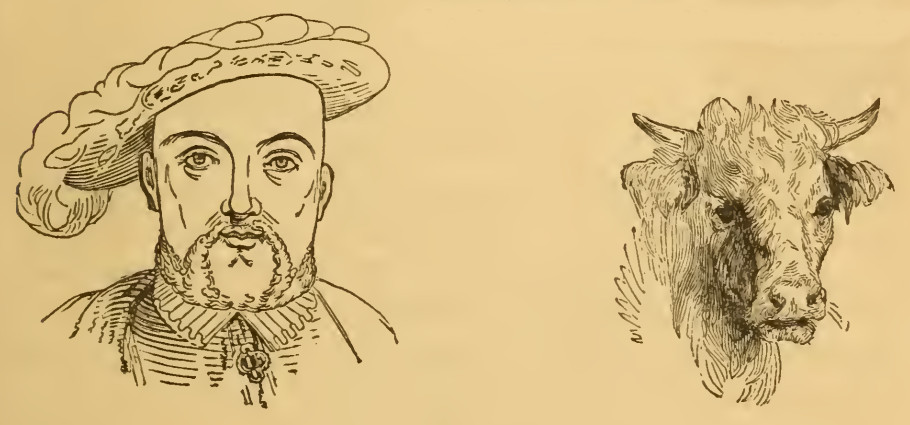
In his Comparative Physiognomy of 1852, American physician James Redfield claimed that people of a given nationality tend to resemble a certain animal, and that the animal’s disposition illuminates the national character. For example, Henry VIII, a representative Englishman, resembles a bull: “A ‘bull-neck’ suggests the idea of a tyrannical disposition, or of irresistible desire, and is never spoken of in the way of compliment. … When oxen draw together in a yoke, they lean away from each other, so as to be under the necessity of holding each other up. This is on account of their great repulsiveness — a trait which was mentioned as being a prominent element of the English character.”
The table of contents gives the general tone:
Chapter 2. Resemblances of Germans to Lions
Chapter 14. Resemblances of Laplanders to Reindeers
Chapter 16. Resemblances of Arabs to Camels
Chapter 19. Resemblances of Italians to Horses
Chapter 23. Resemblances of Chinamen to Hogs
Chapter 29. Resemblances of Frenchmen to Frogs and Alligators
Chapter 34. Resemblances of Jews to Goats
He even compares Turks to turkeys. I’m not aware that he ever actually visited these places, but I suppose that’s not necessary to reach these sorts of conclusions.
The whole thing is in the Internet Archive.
03/24/2022 UPDATE: Reader Manuel Saiz sent this video:
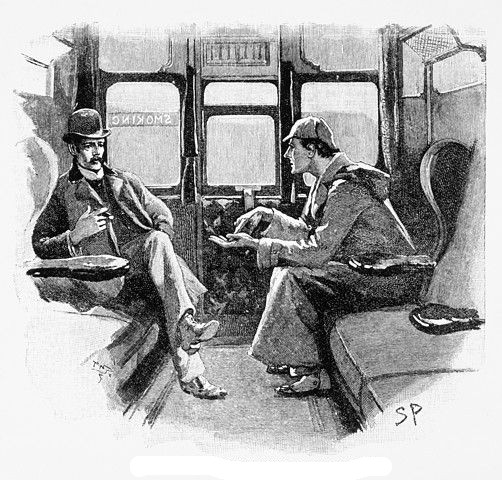
I seem to be on a Sherlock Holmes kick lately. A few oddities about Dr. Watson:
At its annual dinner, the Sherlock Holmes literary society the Baker Street Irregulars always toasts the second Mrs. Watson. This was the toast in 2002:
Watson had a second wife
But, did he lead a double life?
He had two wounds; he had two names
(One was John, the other James).
He often claimed he dined alone
Yet quaffed whole bottlesful of Beaune.
He’d disappear for days on end
Accompanying his clever friend,
Then lame excuses where he’d been
Were published in Strand Magazine.
And so to the spouse of this pain in the ass
We raise a toast and lift our glass.
(From Roger Johnson and Jean Upton, The Sherlock Holmes Miscellany, 2012.)
In Book 11 of the Odyssey, Odysseus encounters his mother in Hades and asks her seven questions. She answers all seven, but strangely in reverse order:
A – What killed you?
B – A long sickness?
C – Or Artemis with her arrows?
D – How is my father?
E – How is my son?
F – Are my possessions safe?
G – Has my wife been faithful?
G – Your wife has been faithful.
F – Your possessions are safe.
E – Your son is thriving.
D – Your father is alive but in poor condition.
C – Artemis did not kill me with her arrows.
B – Nor did a sickness kill me.
A – But my longing for you killed me.
This reversal is called chiasmus, and it appears throughout oral literature. Apart from its aesthetic effect, it’s thought that it may have helped ancient poets to remember long passages and to recall the structure of a complex story. Of the Iliad, classicist Cedric Whitman writes, “Not only are certain whole books of the poem arranged in self-reversing, or balancing, designs, but the poem as a whole is, in a way, an enormous hysteron proteron, in which books balance books and scenes balance scenes by similarity or antithesis, with the most amazing virtuosity.”
Some of these patterns are wrought on such a huge scale that it’s hard to believe that a listening audience could even recognize them. Why then offer them? Whitman gives two reasons. One, a poet might perform a feat of virtuosity for its own sake, even if the audience overlooks it. And two, “The human mind is a strange organ, and one which perceives many things without conscious or articulate knowledge of them, and responds to them with emotions necessarily and appropriately vague.”
(Cedric Whitman, Homer and the Heroic Tradition, 1958; and Steve Reece, “The Three Circuits of the Suitors: A Ring Composition in Odyssey 17-22,” Oral Tradition, 10:1 [1995], 207-229.)
This is pleasing: The first library card catalogs were made using playing cards. During the French Revolution the government created a new system of public libraries, and in order to inventory the books they created the “French Cataloging Code of 1791,” in which bibliographic data was written on playing cards, which were sturdy, uniform, and plentiful. A photo is here.
In The Card Catalog, its affectionate tribute to this now outmoded tool, the Library of Congress notes that 1.2 million cards representing more than 3 million volumes were recorded using this system within 3 years. “Although the ambitious cataloging project did not result in the formation of a national catalog, it did demonstrate the potential of utilizing a uniform format.” (Also: “Deuces and aces were reserved for the longest titles, as those cards had the most space on which to write.”)
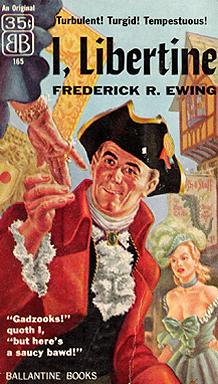
Irritated at the way bestseller lists were compiled in the 1950s, late-night radio host Jean Shepherd asked his listeners to visit bookstores and request a nonexistent book, I, Libertine, by the imaginary author Frederick R. Ewing.
The number of requests drove the title onto the New York Times bestseller list, and, encouraged by its popularity, bookstores began to order the novel. So Shepherd and publisher Ian Ballantine got novelist Theodore Sturgeon to write it, following the plot that Shepherd had described to his listeners. (Sturgeon fell asleep while trying to write the whole book in one marathon session, so Ballantine’s wife Betty had to write the last chapter.)
Ballantine Books published the novel in September 1956, using a photo of Shepherd in place of Ewing, and donated the proceeds to charity.
The Wall Street Journal exposed the hoax a few weeks before publication. “Mr. Ballantine’s idea, though simple enough, was a startling one, for publishers consider it one of the greatest possible tragedies to print a book later discovered to be the work of a literary faker,” wrote reporter Carter Henderson. “At Simon & Schuster, Inc., faces still redden when Joan Lowell’s autobiographical ‘Cradle of the Deep’ is mentioned even though this phony tale of a young girl’s spectacularly adventurous life at sea was published in 1929.”
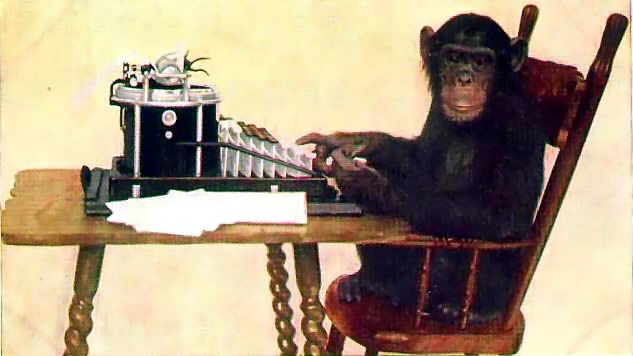
In 2003, students from the University of Plymouth placed a computer keyboard in the enclosure of six Celebes crested macaques in the Paignton Zoo in Devon for one month.
They published the result as Notes Towards the Complete Works of Shakespeare.
It’s hard to know what to make of this. “They are very intentional, deliberate, and very dextrous, so they do want to interact with stuff you give them,” offered zoo biologist Vicki Melfi.
But “the monkeys aren’t reducible to a random process,” concluded test designer Geoff Cox. “They get bored and they shit on the keyboard rather than type.”